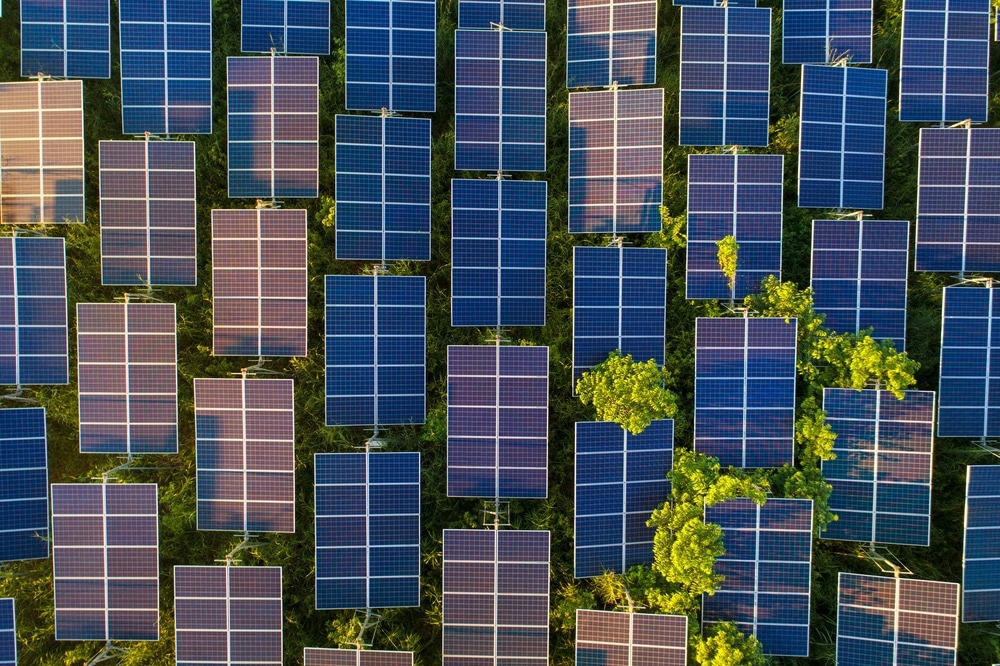In a paper recently published in the journal ACS Energy Letters, researchers reviewed and summarized molecular modeling and synthesis approaches used for advancements in the engineering of Y-series-based polymer acceptors to attain power conversion efficiencies (PCEs) over 18% in all-polymer solar cells (all-PSCs).

Study: Y-Series-Based Polymer Acceptors for High-Performance All-Polymer Solar Cells in Binary and Non-binary Systems. Image Credit: Thongsuk7824/Shutterstock.com
Background
Recent studies have demonstrated that bulk heterojunction (BHJ) PSCs made up of conjugated polymer acceptor and donor blends may generate inexpensive, large-area devices using simple solution methods. A study published in 2017 offered an approach to polymerizing small-molecule acceptors (SMAs) of the acceptor-donor-acceptor (A-D-A) type with a narrow band gap in order to fabricate a distinctive polymer acceptor. It was discovered that such polymer acceptors maintained all the advantages of A-D-A-type SMAs along with the polymer backbone's distinctive properties.
Furthermore, several researchers identified the benefits of Y-series-type SMA in terms of enhanced system performance and suggested that developing PSCs with Y-series-based polymer acceptors can be a substantial contribution to the advancement of PSCs. Y-series-type SMAs have a unique A-DA′D-A core structure and are recognized as the most suitable choice to date owing to remarkable features such as an extended absorption range (950 nm), formation of a 3D interpenetrating framework enhancing exciton delocalization and charge transport efficiency, and electron mobility ranging from 10-4 to 10-3 cm2 V-1s-1 accompanied by a significantly low loss in energy.
Acceptors for Binary Layers
Several design approaches for the SMA linking and analog units have been employed. According to side-chain engineering studies, adding a long alkyl chain to the PJ1 series might enhance the performance of the associated organic photovoltaic (OPV) devices by increasing the solubility of the higher molecular weight polymers. As the polymer acceptor's molecular weight may directly impact its chain entanglement, solubility, viscoelasticity, and chain packing behavior, several studies have determined that the optimization of the molecular weight for each polymer design is critical to improving the resultant device performance.
Most of the Y-series-based polymer acceptors have been produced utilizing two A′-core types: benzotriazole (BTA) and benzothiadiazole (BT). However, it has been found that the BTA core may provide greater benefits in terms of adjusting the polymer chain's molecular packing and solubility due to the extra alkyl side chain linked to nitrogen. Another study exhibited polymer acceptors based on the Y-series moiety containing the BTA unit in DA′D fused central core while considering that the alkyl chain could provide high solubility.
The BTA core-based polymer acceptor has a higher-lying lowest unoccupied energy level (LUMO) and with an extra N-alkyl chain, it can increase the molecular packing than the BT-based polymer acceptor having high electronegativity and mobility. As a result, it has been identified as a potential material that may be employed among all-PSCs.
Another study described a variety of polymer acceptors with various isomerized thiophene-fused end groups. Devices based on this polymer demonstrated effective charge carrier production and transport capabilities, providing a high and consistent PCE of 14.3%. The regioregularity of polymer acceptors consisting of SMA with fluorinated end groups was also examined.
Furthermore, a study designed the polymer acceptor PY-V-γ with a vinylene structure with a center of symmetry as the connecting unit to eliminate the molecular twisting and randomness in the Y-series-based polymer acceptor. The inclusion of a D-A-D acceptor moiety to the Y-series-based polymer acceptors in the form of a linkage unit might reduce energy levels and open more electron transport pathways. Moreover, it has been determined feasible to change the all-PSCs performances by modifying the regioregularity and the linker structure of the Y-series-based monomer.
Acceptors for Non-Binary Layers
Regarding device engineering, a nonbinary active layer that could generate a durable and robust all-PSC utilizing a Y-series polymer acceptor was also produced using a ternary strategy. This involved adding a third component to improve host material miscibility while enhancing stability and minimizing carrier recombination losses. Another strategy consisted of using a single polymer material within the photoactive layer.
Furthermore, to maintain acceptor compatibility, the third component could be a polymer acceptor based on the Y-series. Polymer donors have also been utilized as the third component in two donors/one acceptor (D:D′:A) ternary systems.
Conclusions
To summarize, the researchers demonstrated that all-PSCs with polymer acceptors based on the Y-series exhibited all the advantages as that of SMAs, along with some additional notable features. A suitable linker design is important for controlled molecular aggregation and an effective intermolecular charge transfer.
It was observed that a PCE of 18% was ultimately attained in all-PSCs consisting of Y-series-based polymer acceptors. According to the authors, future strategies to enhance device performance in future applications may include the selection of a novel conjugated core, increased focus on advancing the ternary strategy, controlled active layer microstructures, and introducing Y-series-based polymer acceptors within single-component PSCs.
More from AZoM: How are Bioplastics Made?
Reference
Kataria, M., et al. (2022) Y-Series-Based Polymer Acceptors for High-Performance All-Polymer Solar Cells in Binary and Non-binary Systems, ACS Energy Letters, 0, p. 7, https://pubs.acs.org/doi/10.1021/acsenergylett.2c01541
Disclaimer: The views expressed here are those of the author expressed in their private capacity and do not necessarily represent the views of AZoM.com Limited T/A AZoNetwork the owner and operator of this website. This disclaimer forms part of the Terms and conditions of use of this website.